Amy Baker is Digital Preservation Assistant at Historic England
This year World Digital Preservation Day coincides with another major project for Historic England: the release of the Heritage at Risk Register for 2024, coming late November. As a result, it has been a busy time for the digital preservation team here at Historic England, and so felt like a perfect time to not only celebrate #WDPD2024 but also bring attention to the importance of digital preservation within projects like Heritage at Risk.
Each year Historic England releases a Heritage at Risk Register. This is where vulnerable listed heritage sites are assembled into one register to draw attention to the most at need for safeguarding for the future. By communicating the condition of built heritage, it aims to connect communities to their local heritage to encourage positive development. The 2023 figures state that while there were 159 additions to the At Risk Register, there were also 203 removal for positive reasons. For more information on the Register please visit here.
So, how does the Digital Preservation team play a part of the Heritage at Risk project?
Here at the Historic England Archive we have a small team dedicated to the long-term preservation of digital assets. This involves the accessioning of, and not limited to:
Digital photographs – the picturesque, listed site images by our expert photography team,
Scans – digitising archival maps, town plans and photographic negatives dating to the late 1800s,
Recreation drawings – 3D recreations that you may see in English Heritage site textbooks and information boards,
Aerial flight images – recording the urban and rural landscape.
As the digital preservation system develops, we are taking on an expansive range of data including geospatial data and supporting documents. While we want to conserve our digital assets, we also want to make them accessible. We upload most images to our current digital asset management system, Portfolio, where our staff can view images for their own projects. We currently have over 1.1 million digital assets available for viewing on Portfolio.
For the Heritage at Risk project specifically, these sites are quite literally at risk meaning their conservation status is vulnerable. This may be due to neglect, decay, or inappropriate development. Taking photographs and digitally preserving them allows the sites to be digitally recorded. This means if funding is not allocated and the site falls further into disrepair, the site has been, in a way, conserved digitally. This is the role of digital preservation within digital heritage, how to conserve the recordings and representations of heritage sites that may no longer have a physical version, or if the physical version is at risk. The digital photographs of Heritage at Risk sites have increased importance due to the physical site’s vulnerability.
Uses of digital preservation in the HE Archive
Documentary preservation
Saltdean Lido, East Sussex, Grade II*
Listed in 1987, Saltdean Lido boasts a complex history of the auxiliary fire service taking over during WWII. The pool used as a water tank, while the dressing rooms were converted into a church and Sunday school.
Due to the digital archive, we can see the lido at several stages throughout its restoration progress. Historic England added the site to the Heritage at Risk register in 2011 and has been photographed multiple times since then. This is called documentary preservation where photographs taken overtime adds to the site’s overall historic narrative.

Saltdean Lido before reconstruction, Seaside Project 2014 © Historic England Archive
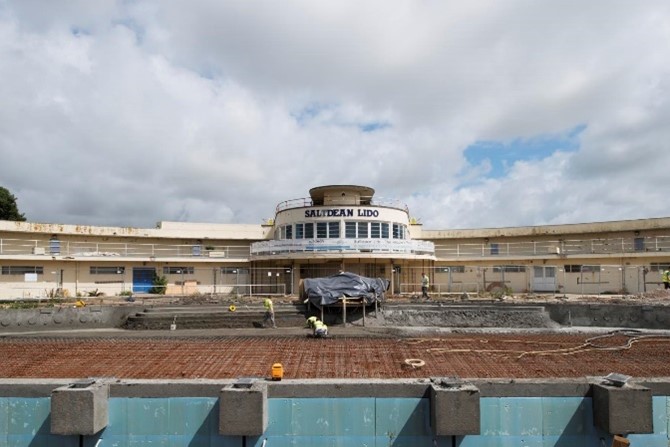
Saltdean Lido during reconstruction, Heritage at Risk 2016 © Historic England Archive

Saltdean Lido during reconstruction, Heritage at Risk 2022 © Historic England Archive
Increased accessibility
Kensal Green (All Souls) Cemetery, London, Grade I
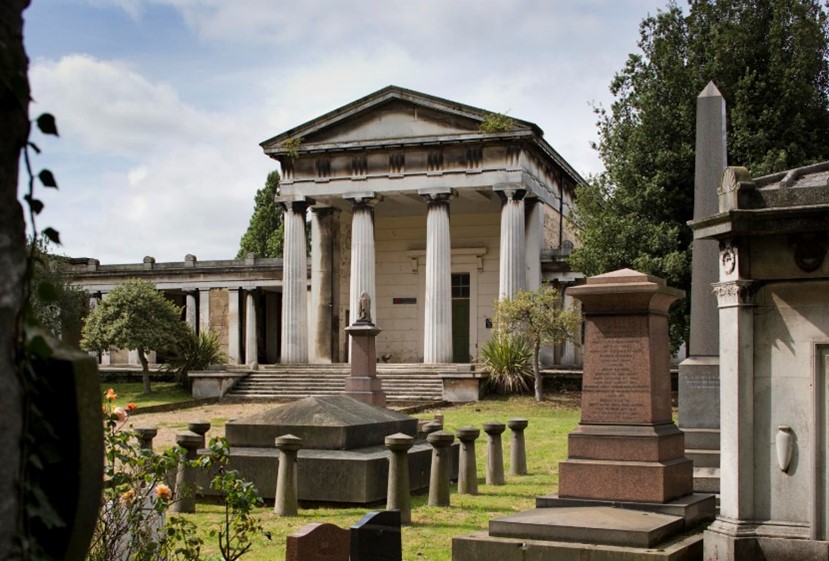
Kensal Green Cemetery, Heritage At Risk 2014 © Historic England Archive
Opened in 1833, Kensal Green was London’s first nineteenth century cemetery open to the public. The cemetery is also home to over one hundred listed monuments and buildings in addition to being a listed Park and Garden. Consequently, the digital archive is home to an extensive range of photographs highlighting the historic character. Another benefit of the digital preservation process is the increased accessibility of born-digital and digitised materials. Kensal Green Cemetery (All Souls) has many related photographs, some of which have been digitised from negatives and deposited into the digital archive. These then can be made accessible to a much wider audience.
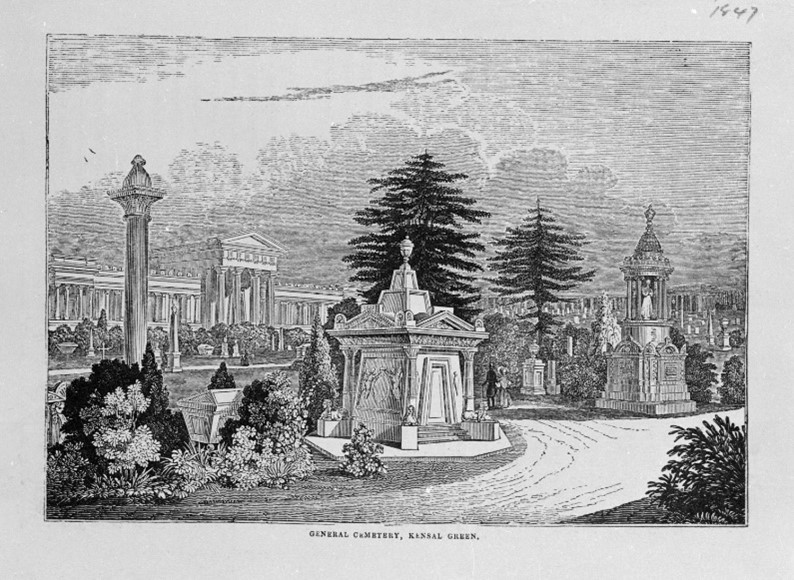
Copy of an engraving, ‘General Cemetery, Kensal Green’ 1847. Source: Historic England Archive
An interesting example is this digital copy of an engraving from 1847. The engraving was photographed in 1979, scanned in 2007, and deposited into our digital archive. The digitisation process has made this artwork more accessible.
Metadata
There can’t be a digital preservation article without discussing metadata! Metadata is particularly useful in the digital archive, being used to catalogue the deposits and help them not get lost.
Former Stables to Bradgate House, Leicestershire, Grade II*
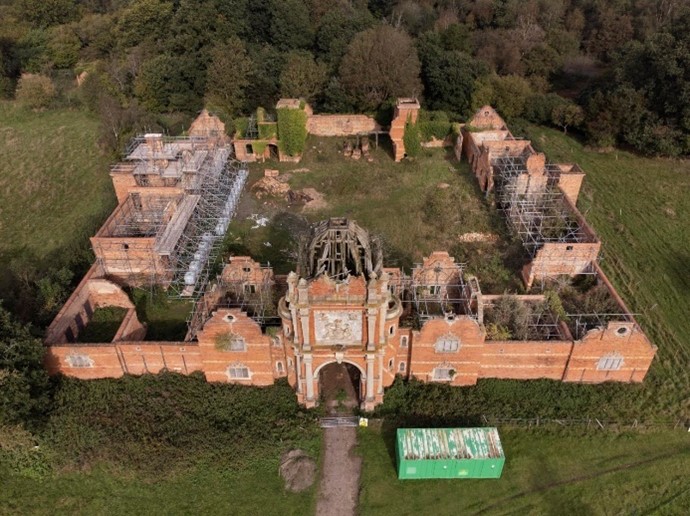
Former Stables to Bradgate House, Heritage At Risk 2023 © Historic England Archive
I’ve chosen a photo from Heritage at Risk 2023. However, we can understand a lot about the photograph without viewing it due to its metadata.
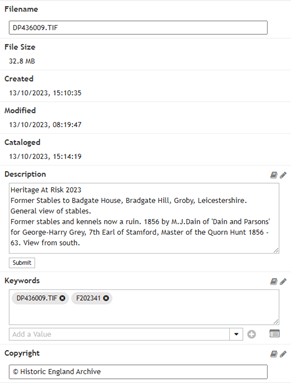

The above is a snapshot into the available metadata we have for each image on our digital asset management system. Most of the metadata is created by our photographers, which then stays untouched and loaded onto Portfolio. It includes important data like creation time and date, and catalogued time and date. Recording the history of our digital objects supports both authenticity and trust in the archive.
This has been a small insight into digital preservation and its role within the Historic England Archive, specifically the Heritage At Risk project. The Heritage At Risk programme is one of the many schemes Historic England delivers to bring communities together by celebrating local heritage. It aims to bring those buildings and sites into use, protect the character of historic places, share community stories, and restore pride in local heritage. As a new member of Historic England, I’m very happy to be part of such a project!
